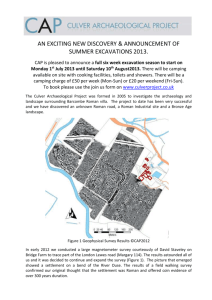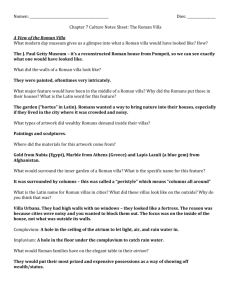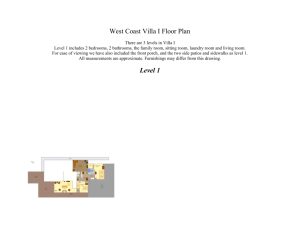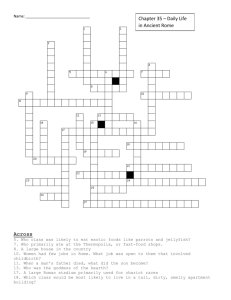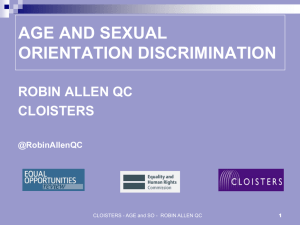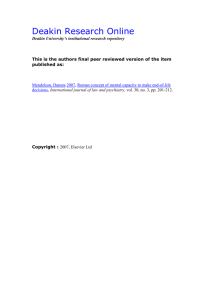Ch. 7 enrichment activity
advertisement
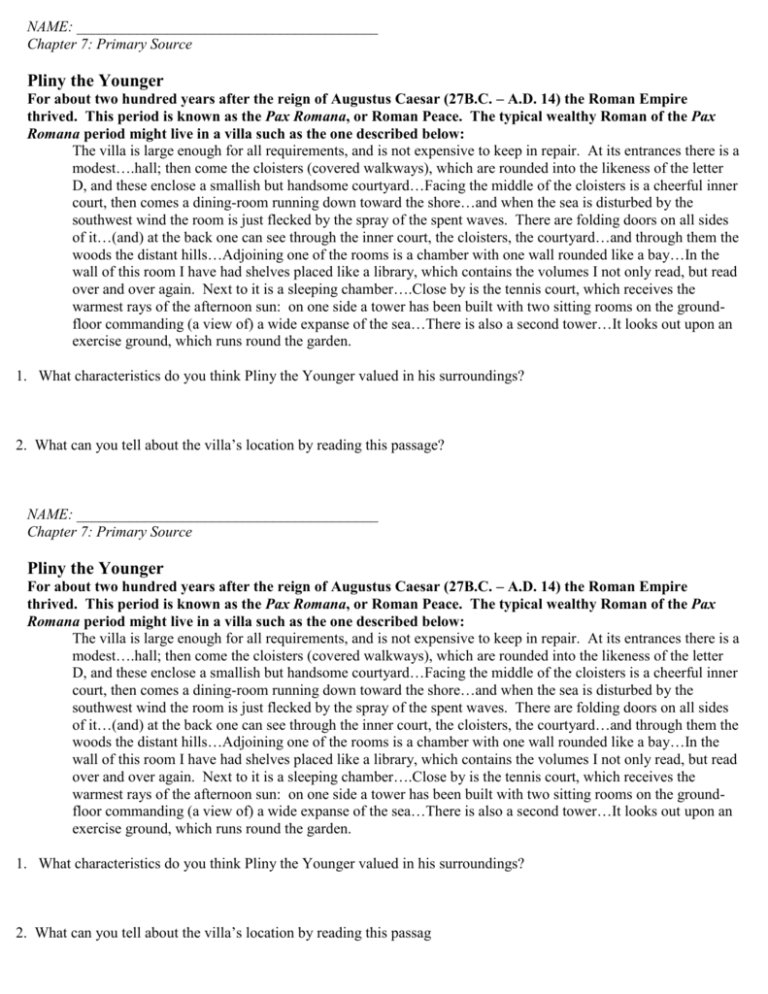
NAME: ________________________________________ Chapter 7: Primary Source Pliny the Younger For about two hundred years after the reign of Augustus Caesar (27B.C. – A.D. 14) the Roman Empire thrived. This period is known as the Pax Romana, or Roman Peace. The typical wealthy Roman of the Pax Romana period might live in a villa such as the one described below: The villa is large enough for all requirements, and is not expensive to keep in repair. At its entrances there is a modest….hall; then come the cloisters (covered walkways), which are rounded into the likeness of the letter D, and these enclose a smallish but handsome courtyard…Facing the middle of the cloisters is a cheerful inner court, then comes a dining-room running down toward the shore…and when the sea is disturbed by the southwest wind the room is just flecked by the spray of the spent waves. There are folding doors on all sides of it…(and) at the back one can see through the inner court, the cloisters, the courtyard…and through them the woods the distant hills…Adjoining one of the rooms is a chamber with one wall rounded like a bay…In the wall of this room I have had shelves placed like a library, which contains the volumes I not only read, but read over and over again. Next to it is a sleeping chamber….Close by is the tennis court, which receives the warmest rays of the afternoon sun: on one side a tower has been built with two sitting rooms on the groundfloor commanding (a view of) a wide expanse of the sea…There is also a second tower…It looks out upon an exercise ground, which runs round the garden. 1. What characteristics do you think Pliny the Younger valued in his surroundings? 2. What can you tell about the villa’s location by reading this passage? NAME: ________________________________________ Chapter 7: Primary Source Pliny the Younger For about two hundred years after the reign of Augustus Caesar (27B.C. – A.D. 14) the Roman Empire thrived. This period is known as the Pax Romana, or Roman Peace. The typical wealthy Roman of the Pax Romana period might live in a villa such as the one described below: The villa is large enough for all requirements, and is not expensive to keep in repair. At its entrances there is a modest….hall; then come the cloisters (covered walkways), which are rounded into the likeness of the letter D, and these enclose a smallish but handsome courtyard…Facing the middle of the cloisters is a cheerful inner court, then comes a dining-room running down toward the shore…and when the sea is disturbed by the southwest wind the room is just flecked by the spray of the spent waves. There are folding doors on all sides of it…(and) at the back one can see through the inner court, the cloisters, the courtyard…and through them the woods the distant hills…Adjoining one of the rooms is a chamber with one wall rounded like a bay…In the wall of this room I have had shelves placed like a library, which contains the volumes I not only read, but read over and over again. Next to it is a sleeping chamber….Close by is the tennis court, which receives the warmest rays of the afternoon sun: on one side a tower has been built with two sitting rooms on the groundfloor commanding (a view of) a wide expanse of the sea…There is also a second tower…It looks out upon an exercise ground, which runs round the garden. 1. What characteristics do you think Pliny the Younger valued in his surroundings? 2. What can you tell about the villa’s location by reading this passag




